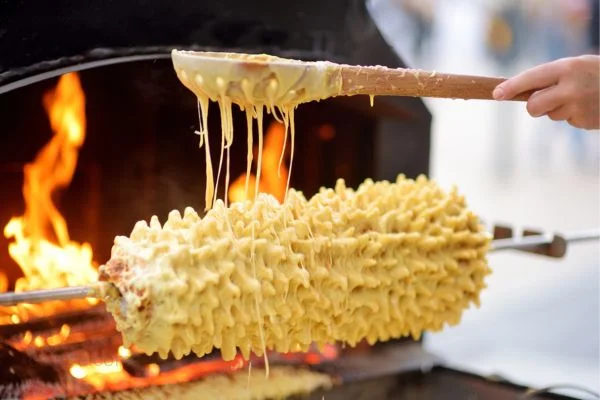Lithuanian tree cake, also known as šakotis, is a traditional Lithuanian dessert that holds a significant place in the country’s culinary heritage. This unique cake is a true masterpiece, featuring a distinctive tree-like shape with delicate layers of dough spiraled around a rotating spit. As it bakes, the cake takes on the appearance of a beautifully branched tree, which adds to its charm and allure.

What is Lithuanian Tree Cake?
Lithuanian tree cake is a special type of spit cake made from a simple mixture of eggs, butter, sugar, flour, and cream.
It is traditionally prepared by skilled bakers who have mastered the art of creating its intricate shape and texture.
The process of making the cake involves layering and rolling the dough on a spit, then slowly baking it over an open fire or in a specially designed oven.
The History of Lithuanian Tree Cake
The origins of Lithuanian tree cake can be traced back to the 16th century when it first appeared in Lithuania during wedding celebrations and other important events. Over the centuries, the cake has become a symbol of joy, happiness, and togetherness among the Lithuanian people.
The Traditional Recipe
The traditional recipe for Lithuanian tree cake remains unchanged for generations. It requires a careful balance of ingredients, with each element contributing to the cake’s unique taste and texture.
The bakers use high-quality eggs, unsalted butter, granulated sugar, all-purpose flour, and fresh cream to create the perfect dough.
The Unique Taste of Lithuanian Tree Cake
Lithuanian tree cake boasts a flavor that is truly unlike any other dessert. Its taste can be described as:
A Delicate Texture
The cake’s delicate layers, achieved through the layering and rolling process, create a wonderful melt-in-your-mouth experience.
The combination of crisp outer layers and soft inner dough results in a perfect balance of textures.
Rich Flavors of Caramel and Vanilla
The use of eggs and sugar in the recipe leads to a delightful caramelization during baking. This adds a rich sweetness to the cake, enhanced by the subtle undertones of vanilla.
Hints of Cinnamon and Nutmeg
Some variations of Lithuanian tree cake include the addition of cinnamon and nutmeg, infusing the dessert with warm and comforting spices that complement the sweetness.
The Baking Process
The baking process of Lithuanian tree cake is an art in itself. Skilled bakers follow a meticulous procedure to ensure the cake’s iconic tree-like appearance.
Layering and Rolling the Dough
The dough is spread thinly on a rotating spit, and multiple layers are added on top of each other. The bakers gently roll the dough, creating the characteristic tree rings.
Slow Baking on a Rotating Spit
The spit is then placed over an open fire or in an oven, and the cake slowly rotates to ensure even baking. The slow cooking process allows the layers to merge together seamlessly.
Variations of Lithuanian Tree Cake
While the traditional recipe remains the most beloved, there are various regional and modern adaptations of Lithuanian tree cake.
Some bakers experiment with different flavors, fillings, and toppings, adding their unique twist to this classic dessert.
How to Enjoy Lithuanian Tree Cake
Lithuanian tree cake is best enjoyed with friends and family, and it pairs wonderfully with various beverages. Here are some tips for savoring this delightful treat:
Pairing with Beverages
The cake’s sweetness complements the bitterness of coffee, making it an excellent choice for an afternoon snack or dessert.
Serving Suggestions
Serve the cake with a dusting of powdered sugar or a dollop of fresh cream for an extra touch of indulgence.
Popular Locations to Try Lithuanian Tree Cake
Visiting Lithuania offers the best opportunity to taste authentic Lithuanian tree cake.
Many bakeries and local cafes serve this delicacy, and it is a must-try for anyone exploring the country’s culinary delights.
Health Benefits of Lithuanian Tree Cake
While Lithuanian tree cake is undoubtedly a treat, it is essential to enjoy it in moderation.
The cake’s ingredients provide a source of energy and essential nutrients, but it is best suited as an occasional indulgence rather than a regular dietary staple.
FAQs
Yes, it is possible to make Lithuanian tree cake at home, but it requires some baking skills and patience due to its intricate preparation process.
To keep the cake fresh, store it in an airtight container at room temperature. It is best consumed within a few days of baking.
The traditional recipe contains wheat flour, so it is not gluten-free. However, there are gluten-free variations available for those with dietary restrictions.
Lithuanian tree cake is commonly served at weddings, birthdays, and other festive celebrations as a symbol of joy and prosperity.
Conclusion
In conclusion, Lithuanian tree cake, or šakotis, is a delightful dessert that offers a unique taste and texture experience.
Its fascinating tree-like appearance and rich flavors make it a cherished symbol of Lithuanian culture and traditions.
Whether enjoyed on special occasions or as an everyday indulgence, this cake is sure to leave a lasting impression on anyone fortunate enough to taste it.
